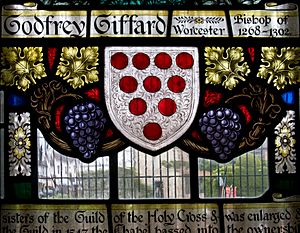Godfrey Giffard facts for kids
Quick facts for kids Godfrey Giffard |
|
|---|---|
| Bishop of Worcester | |

Memorial window in the Chapel of the Holy Cross, Stratford-upon-Avon
|
|
| Elected | May 1268 |
| Reign ended | 26 January 1302 |
| Predecessor | Nicholas of Ely |
| Successor | John St German |
| Orders | |
| Consecration | 23 September 1268 by Boniface of Savoy |
| Personal details | |
| Born | c. 1235 |
| Died | 26 January 1302 |
| Denomination | Catholic |
| Previous post | Archdeacon of York |
Godfrey Giffard (around 1235–1302) was an important person in England during the 1200s. He held several major roles. He was the Chancellor of the Exchequer (like a finance minister) and the Lord Chancellor of England (a top government official). He also served as the Bishop of Worcester, a leader in the church.
Contents
Early Life and Family
Godfrey Giffard was born around 1235. His father, Hugh Giffard, was a royal judge. Godfrey's older brother, Walter Giffard, became the Archbishop of York, a very powerful church position. Walter's success helped Godfrey get many important jobs. Godfrey also had a sister named Mabel, who was the abbess (leader) of Shaftesbury Abbey, a large monastery for women.
Godfrey's Career
Godfrey Giffard gained many positions thanks to his brother's influence. Here are some of the jobs he held:
- Canon of Wells Cathedral (a church official)
- Rector of Mells, Somerset (a church leader in a specific area)
- Rector of Attleborough in Norfolk
- Archdeacon of Barnstaple (a senior church official)
- Archdeacon of York
- Chancellor of the Exchequer (managed the country's money)
- Chancellor of England (a chief minister to the king)
- Rector of Adlingfleet
Some people complained to the Pope that Godfrey received these jobs because of his brother. They said he was only in minor church orders and lacked enough learning.
Becoming Bishop of Worcester
Godfrey was still the Chancellor of England when he was chosen to be the Bishop of Worcester. This happened in May 1268. The previous bishop, Nicholas of Ely, had moved to another church position.
King Henry III of England approved Godfrey's appointment. He officially received control of the church's lands and income in June 1268. After a short delay, Archbishop Boniface of Savoy confirmed his election. Godfrey was consecrated (made a bishop) on September 23, 1268, in Canterbury. He was officially welcomed into Worcester Cathedral on Christmas Day that same year.
Godfrey remained Chancellor until October 1268. For his support and the work of his clerks, he received a grant of five hundred marks each year.
Important Royal Duties
Godfrey Giffard took on several important tasks for the king:
- In 1272, he worked with Roger de Meyland, the Bishop of Lichfield, to negotiate with Llywelyn ap Gruffudd of Wales.
- In May 1273, he traveled abroad with other bishops to meet King Edward I. The king was returning from the Holy Land.
- He was appointed to a special group with Roger Mortimer. Their job was to look into problems reported by scholars at Oxford University.
- In 1278, he served as a traveling judge in Hertfordshire and Kent.
In 1279, Godfrey inherited a lot of property from his brother, the Archbishop of York. He was also one of four people chosen by King Edward I in 1289. Their mission was to discuss sending Margaret of Norway to Scotland.
Godfrey Giffard led the See of Worcester for over 33 years. Most of his work during this time focused on his own diocese (the area under his church authority).
Godfrey's Time as Bishop
As bishop, Godfrey had many disagreements with the monks of his cathedral. These disputes were often about money and who had authority. For example, they argued about whether he could use some church income for a college he supported.
He also had a big dispute with the Abbot of Westminster. This happened when he removed William of Ledbury, the Prior of Malvern, from his position. The monks of Westminster supported William because Malvern was connected to their Abbey. Even the King got involved. Eventually, Godfrey settled the case. He received some land and agreed not to visit Malvern as often.
Godfrey was known for being kind to the Franciscans, a group of monks. He was even made a brother of their order.
By 1300, Godfrey Giffard was becoming sick. In 1301, some complaints were made against him to the Archbishop. These included charges of freeing serfs (people tied to the land) without permission and favoring his nephews too much.
Death and What He Left Behind
Godfrey Giffard passed away on January 26, 1302. He was buried on February 4 in Worcester Cathedral. His tomb can still be seen there today.
In his will, Godfrey left many gifts to his relatives, including his sister Mabel. He also left money and items to various churches.
Godfrey's nephew, John, inherited his property. However, John later fought against the king and was hanged, losing his estates. These lands were later returned to the family. The Giffords of Weston-sub-Edge later used the symbols of the See of Worcester on their family crest to remember Godfrey.
Even with his disagreements with the monks, Godfrey was a good supporter of his Cathedral. He made the pillars of the choir and lady chapel more beautiful. In 1280, he laid the first stone for the cathedral's new floor.
Godfrey also got permission to strengthen and finish Hartlebury Castle, which another bishop had started. He also helped get permission for fairs (like markets) in Stratford-on-Avon and Blockley. He also secured permission to fortify his palaces in Worcester and Wydindon.

